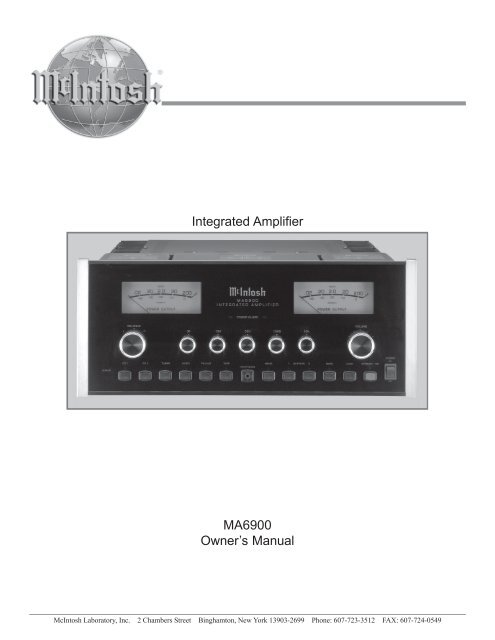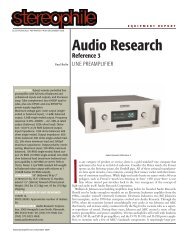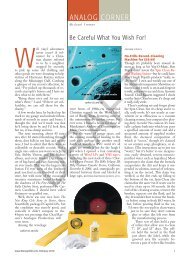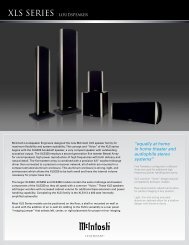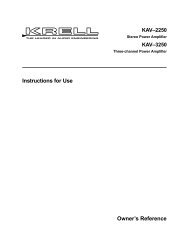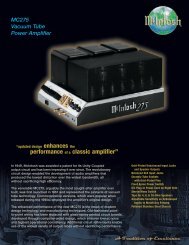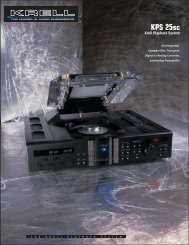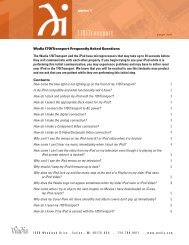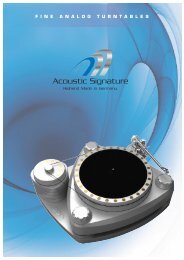MA6900 Owner's Manual Integrated Amplifier
MA6900 Owner's Manual Integrated Amplifier
MA6900 Owner's Manual Integrated Amplifier
You also want an ePaper? Increase the reach of your titles
YUMPU automatically turns print PDFs into web optimized ePapers that Google loves.
<strong>Integrated</strong> <strong>Amplifier</strong><br />
<strong>MA6900</strong><br />
Owner’s <strong>Manual</strong><br />
McIntosh Laboratory, Inc. 2 Chambers Street Binghamton, New York 13903-2699 Phone: 607-723-3512 FAX: 607-724-0549
The lightning flash with arrowhead,<br />
within an equilateral triangle, is intended<br />
to alert the user to the presence of<br />
uninsulated “dangerous voltage” within<br />
the product’s enclosure that may be of<br />
sufficient magnitude to constitute a risk<br />
of electric shock to persons.<br />
The exclamation point within an equilateral<br />
triangle is intended to alert the<br />
user to the presence of important<br />
operating and maintenance (servicing)<br />
instructions in the literature accompanying<br />
the appliance.<br />
WARNING - TO REDUCE RISK OF<br />
FIRE OR ELECTRICAL SHOCK, DO<br />
NOT EXPOSE THIS EQUIPMENT TO<br />
RAIN OR MOISTURE.<br />
NO USER-SERVICEABLE PARTS<br />
INSIDE. REFER SERVICING TO<br />
QUALIFIED PERSONNEL.<br />
To prevent the risk of electric shock, do not remove cover or<br />
back. No user serviceable parts inside.<br />
IMPORTANT SAFETY<br />
INSTRUCTIONS!<br />
PLEASE READ THEM BEFORE<br />
OPERATING THIS EQUIPMENT.<br />
1. Read these instructions.<br />
2. Keep these instructions.<br />
3. Heed all warnings.<br />
4. Follow all instructions.<br />
5. Do not use this apparatus near water.<br />
6. Clean only with a dry cloth.<br />
7. Do not block any ventilation openings. Install in<br />
accordance with the manufacturer’s instructions.<br />
8. Do not install near any heat sources such as<br />
radiators, heat registers, stoves, or other<br />
apparatus (including amplifiers) that produce<br />
heat.<br />
9. Do not defeat the safety purpose of the polarized<br />
or grounding-type plug. A polarized plug has two<br />
blades with one wider than the other. A grounding<br />
type plug has two blades and a third grounding<br />
prong. The wide blade or the third prong are<br />
provided for your safety. If the provided plug<br />
does not fit into your outlet, consult an electrician<br />
for replacement of the obsolete outlet.<br />
10. Protect the power cord from being walked on or<br />
pinched particularly at plugs, convenience<br />
receptacles, and the point where they exit from<br />
the apparatus.<br />
11. Only use attachments/accessories specified by the<br />
manufacturer.<br />
12. Use only with the cart, stand, tripod,<br />
bracket, or table specified by the<br />
manufacturer, or sold with the<br />
apparatus. When a cart is used, use<br />
caution when moving the cart/<br />
apparatus combination to avoid injury from tipover.<br />
13. Unplug this apparatus during lightning storms or<br />
when unused for long periods of time.<br />
14. Refer all servicing to qualified service personnel.<br />
Servicing is required when the apparatus has<br />
been damaged in any way, such as power-supply<br />
cord or plug is damaged, liquid has been spilled<br />
or objects have fallen into the apparatus, the<br />
apparatus has been exposed to rain or moisture,<br />
does not operate normally, or has been dropped.<br />
15. Do not expose this equipment to dripping or<br />
splashing and ensure that no objects filled with<br />
liquids, such as vases, are placed on the<br />
equipment.<br />
16. To completely disconnect this equipment from<br />
the a.c. mains, disconnect the power supply cord<br />
plug from the a.c. receptacle.<br />
17. The mains plug of the power supply cord shall<br />
remain readily operable.<br />
2
Thank You<br />
Your decision to own this McIntosh <strong>MA6900</strong> <strong>Integrated</strong><br />
<strong>Amplifier</strong> ranks you at the very top among discriminating<br />
music listeners. You now have “The Best.” The McIntosh<br />
dedication to “Quality,” is assurance that you will receive<br />
many years of musical enjoyment from this unit.<br />
Please take a short time to read the information in this<br />
manual. We want you to be as familiar as possible with all<br />
the features and functions of your new McIntosh.<br />
Please Take A Moment<br />
The serial number, purchase date and McIntosh dealer<br />
name are important to you for possible insurance claim or<br />
future service. The spaces below have been provided for<br />
you to record that information:<br />
Serial Number:<br />
Purchase Date:<br />
Dealer Name:<br />
Technical Assistance<br />
If at any time you have questions about your McIntosh<br />
product, contact your McIntosh dealer who is familiar with<br />
your McIntosh equipment and any other brands that may<br />
be part of your system. If you or your dealer wish additional<br />
help concerning a suspected problem, you can receive<br />
technical assistance for all McIntosh products at:<br />
Table of Contents<br />
Safety Instructions ............................................................ 2<br />
Thank You and Please Take a Moment............................. 3<br />
Technical Assistance and Customer Service .................... 3<br />
Table of Contents .............................................................. 3<br />
Important Information ...................................................... 4<br />
Connector Information ..................................................... 4<br />
Introduction ...................................................................... 4<br />
Performance Features ....................................................... 4<br />
Dimensions ....................................................................... 5<br />
Installation ........................................................................ 6<br />
Rear Panel Connections and Switch ................................. 7<br />
How to Connect for Loudspeakers ................................... 8<br />
How to Connect for Audio and Data Control ................... 9<br />
How to Connect for Video .............................................. 10<br />
How to Connect for a Second Room .............................. 11<br />
Front Panel Controls, Display, Indicator Push-Button<br />
and Switch ...................................................................... 12<br />
How to Operate............................................................... 13<br />
Remote Control Push-Buttons ........................................ 16<br />
How to Operate by Remote Control ............................... 17<br />
Technical Description ..................................................... 18<br />
Specifications ................................................................. 22<br />
Packing Instruction ......................................................... 23<br />
McIntosh Laboratory, Inc.<br />
2 Chambers Street<br />
Binghamton, New York 13903<br />
Phone: 607-723-1545<br />
Fax: 607-723-3636<br />
Customer Service<br />
If it is determined that your McIntosh product is in need of<br />
repair, you can return it to your dealer. You can also return<br />
it to the McIntosh Laboratory Service Department. For assistance<br />
on factory repair return procedure, contact the<br />
McIntosh Service Department at:<br />
McIntosh Laboratory, Inc.<br />
2 Chambers Street<br />
Binghamton, New York 13903<br />
Phone: 607-723-3515<br />
Fax: 607-723-1917<br />
Copyright 2004 © by McIntosh Laboratory, Inc.<br />
3
Introduction and Performance Features<br />
Important Information<br />
1. The following parts are available from the McIntosh Parts<br />
Department:<br />
Power Control Cable Part No. 170-202<br />
Six foot, 2 conductor shielded, with two 1/8 inch stereo<br />
mini phone plugs.<br />
Jumper Plugs Part No. 117-781<br />
RCA Phono Jumpers, 14mm center spacing.<br />
2. For additional connection information, refer to the owner’s<br />
manual(s) for any component(s) connected to the <strong>MA6900</strong>.<br />
3. The <strong>MA6900</strong> mutes the speaker outputs for approximately two<br />
seconds when first turned on.<br />
4. It is very important that loudspeaker cables of adequate size<br />
be used, so that there will be no power loss. The size is<br />
specified in Gauge Numbers or AWG (American Wire Gauge).<br />
The smaller the Gauge number, the larger the wire size:<br />
If your loudspeaker cables are 50 feet (38.1m) or less,<br />
use at least 14 Gauge.<br />
If your loudspeaker cables are 100 feet (76.2m) or less,<br />
use at least 12 Gauge.<br />
5. In the event that the <strong>MA6900</strong> over heats, due to improper<br />
ventilation and/or high ambient temperature, the protection<br />
circuits will activate. The Front Panel Power Guard LEDs<br />
will continuously indicate ON and the audio will be muted.<br />
When the <strong>MA6900</strong> has returned to a safe operating<br />
temperature, normal operation will resume.<br />
Connector Information<br />
XLR Connectors<br />
Below is the Pin configuration for the XLR Balanced Input<br />
Connectors on the <strong>MA6900</strong>. Refer to the diagram for connection:<br />
PIN 1: Shield/Ground<br />
Pin 2<br />
PIN 2: + Input<br />
Pin 1<br />
PIN 3: - Input<br />
Pin 3<br />
Power Control and Trigger Connectors<br />
The <strong>MA6900</strong>’s Power Control Outputs provide a 5 volt<br />
signal. Use a 1/8 inch stereo mini<br />
phone plug to connect to the Positive<br />
Power Control Input on other<br />
N/C<br />
McIntosh Components.<br />
Ground<br />
Data Port Connector<br />
The <strong>MA6900</strong>’s Data Port Output provides Remote Control<br />
Signals. Use a 1/8 inch stereo<br />
mini phone plug to connect to the Data Signal<br />
Data Port Inputs on McIntosh<br />
N/C<br />
Source Units.<br />
Ground<br />
Introduction<br />
Now you can take advantage of traditional McIntosh standards<br />
of excellence in the <strong>MA6900</strong> <strong>Integrated</strong> <strong>Amplifier</strong>.<br />
Two 200 watt high current output channels will drive any<br />
high quality loudspeaker system to its ultimate performance<br />
and the flexible Preamplifier Selection provides for<br />
hookup and control of various input sources. The <strong>MA6900</strong><br />
reproduction is sonically transparent and absolutely accurate.<br />
The McIntosh Sound is “The Sound of the Music Itself.”<br />
Performance Features<br />
• Power Output<br />
The <strong>MA6900</strong> consists of two separate power amplifier<br />
channels, each capable of 200 watts into 2, 4 or 8 ohm<br />
speakers with less than 0.005% distortion.<br />
• Electronic Input Switching<br />
Digital Logic integrated circuits drive Electromagnetic<br />
Switches on all six inputs and operating functions for reliable,<br />
noiseless, distortion free switching.<br />
• Power Guard<br />
Both channels include the patented McIntosh Power Guard<br />
circuit that prevents the amplifier from being overdriven<br />
into clipping, with its harsh distorted sound that can also<br />
damage your valuable loudspeakers.<br />
• Sentry Monitor and Thermal Protection<br />
McIntosh Sentry Monitor power output stage protection<br />
circuits ensure the <strong>MA6900</strong> will have a long and trouble<br />
free operating life. Built-in Thermal Protection Circuits<br />
guard against overheating.<br />
• Patented Autoformers<br />
McIntosh designed and manufactured Output Autoformers<br />
provide an ideal match between the amplifier output stages<br />
and speaker loads of 2, 4 and 8 ohms. The Autoformers<br />
also provide perfect DC protection for your valuable loudspeakers.<br />
• Illuminated Power Meters<br />
The Illuminated Power Output Meters on the <strong>MA6900</strong> are<br />
peak responding, and indicate the power output of the amplifier.<br />
4
<strong>MA6900</strong> Dimensions<br />
<strong>MA6900</strong> Dimensions<br />
The following dimensions can assist in determining the<br />
best location for your <strong>MA6900</strong>. There is additional information<br />
on the next page pertaining to installing the<br />
<strong>MA6900</strong> into cabinets.<br />
17-1/2"<br />
44.45cm<br />
Front View of the <strong>MA6900</strong><br />
7 -1/8"<br />
18.10cm<br />
7 -5/8"<br />
19.37cm<br />
16-1/16"<br />
40.8cm<br />
Rear View of the <strong>MA6900</strong><br />
6"<br />
15.24cm<br />
12-3/16"<br />
30.96cm<br />
18-3/4"<br />
47.63cm<br />
16-1/2"<br />
41.91cm<br />
Side View of the <strong>MA6900</strong><br />
3/16"<br />
0.48cm<br />
6-1/4"<br />
15.88cm<br />
13/16"<br />
2.06cm<br />
13"<br />
33.02cm<br />
1"<br />
2.54cm<br />
5
Installation<br />
Installation<br />
The <strong>MA6900</strong> can be placed upright on a table or shelf,<br />
standing on its four feet. It also can be custom installed in a<br />
piece of furniture or cabinet of your choice. The four feet<br />
may be removed from the bottom of the <strong>MA6900</strong> when it<br />
is custom installed as outlined below. The four feet together<br />
with the mounting screws should be retained for<br />
possible future use if the <strong>MA6900</strong> is removed from the<br />
custom installation and used free standing. The required<br />
panel cutout, ventilation cutout and unit dimensions are<br />
shown.<br />
Always provide<br />
adequate ventilation<br />
for your <strong>MA6900</strong>.<br />
Cool operation ensures<br />
the longest<br />
possible operating<br />
life for any electronic<br />
instrument. Do<br />
not install the<br />
<strong>MA6900</strong> directly<br />
above a heat generating<br />
component such<br />
as a high powered<br />
amplifier. If all the<br />
components are installed<br />
in a single<br />
cabinet, a quiet running<br />
ventilation fan<br />
can be a definite asset<br />
in maintaining all<br />
the system components<br />
at the coolest<br />
possible operating<br />
temperature.<br />
A custom cabinet<br />
installation should<br />
provide the following<br />
minimum spacing<br />
dimensions for<br />
cool operation. Allow<br />
at least 6 inches<br />
(15.24cm) above the<br />
top, 2 inches<br />
(3.81cm) below the<br />
bottom and 1 inch<br />
<strong>MA6900</strong> Front Panel<br />
Custom Cabinet Cutout<br />
<strong>MA6900</strong> Side View<br />
in Custom Cabinet<br />
<strong>MA6900</strong> Bottom View<br />
in Custom Cabinet<br />
Cabinet<br />
Front<br />
Panel<br />
Opening<br />
for Ventilation<br />
Support<br />
Shelf<br />
2"<br />
5.08cm<br />
(2.54cm) on each side of the amplifier, so that airflow is<br />
not obstructed. Allow 20 inches (50.8cm) depth behind the<br />
front panel. Allow 1 inch (2.54cm) in front of the mounting<br />
panel for knob clearance. Be sure to cut out a ventilation<br />
hole in the mounting shelf according to the dimensions in<br />
the drawing.<br />
6"<br />
15.24cm<br />
17-1/16"<br />
43.34cm<br />
Cutout<br />
Opening<br />
for<br />
Ventilation<br />
Cutout Opening for Custom Mounting<br />
Cutout Opening for Ventilation<br />
1"<br />
2.54cm<br />
14-1/2"<br />
36.83cm<br />
13"<br />
33.02cm<br />
6 -5/8"<br />
16.83cm<br />
Chassis<br />
Spacers<br />
10-3/8"<br />
26.35cm<br />
14-1/8"<br />
35.88cm<br />
13"<br />
33.02cm<br />
6
<strong>MA6900</strong> Rear Panel Connections and Switch<br />
Main Fuse holder,<br />
refer to information<br />
on the back panel<br />
of your <strong>MA6900</strong> to<br />
determine the correct<br />
fuse size and<br />
rating<br />
Right OUTPUT<br />
Connections for<br />
2, 4 or 8 ohm<br />
loudspeakers<br />
CD1 balanced INPUTS<br />
accept high level program<br />
source signals<br />
TAPE OUTPUTS<br />
provide the Record<br />
Out Signal<br />
Left OUTPUT<br />
Connections for<br />
2, 4 or 8 ohm<br />
loudspeakers<br />
The EXT<br />
(external)<br />
SENSOR(s)<br />
for a Keypad<br />
or IR Sensor<br />
POWER CONTROL 1 and 2<br />
Outputs send a turn-on signal<br />
to an external McIntosh<br />
Power <strong>Amplifier</strong> when the<br />
<strong>MA6900</strong> Front Panel Output<br />
1 and/or 2 is On<br />
OUTPUTS 1<br />
and 2 supply<br />
the Preamplifier<br />
Output to either<br />
the internal or<br />
external power<br />
amplifier<br />
VIDEO inputs<br />
for audio signals<br />
from a LV, VCR,<br />
TV or an A/V<br />
Selector<br />
GND terminal<br />
accepts a<br />
ground wire<br />
from a turntable<br />
POWER CONTROL<br />
MAIN Output sends<br />
a turn-on signal to an<br />
external McIntosh<br />
Power <strong>Amplifier</strong><br />
when the <strong>MA6900</strong> is<br />
turned on<br />
DATA PORTS send<br />
signals to McIntosh<br />
Compatible Components<br />
to allow control<br />
with the remote control<br />
JUMPER PLUGS<br />
connect the Preamplifier<br />
OUTPUT 1<br />
Jacks to the POWER<br />
AMP IN Jacks and<br />
are needed for normal<br />
operation<br />
TUNER and<br />
CD2 inputs accept<br />
signals<br />
from the output<br />
of a tuner and<br />
CD player<br />
Connect the<br />
<strong>MA6900</strong> power<br />
cord to a live AC<br />
outlet. Refer to information<br />
on the<br />
back panel to determine<br />
the correct<br />
voltage<br />
POWER CONTROL<br />
ACC Output sends a<br />
turn-on signal to a<br />
McIntosh Source<br />
Component or Power<br />
Control unit when the<br />
<strong>MA6900</strong> is turned on<br />
POWER AMP IN<br />
inputs accept signals<br />
from a separate<br />
external<br />
preamplifier<br />
TAPE input<br />
accepts signals<br />
from the output<br />
of a tape<br />
deck<br />
AUX accepts high level program<br />
source signals, PH accepts signals<br />
from a Moving Magnet phono cartridge,<br />
and the small slide switch<br />
selects which one of these two inputs<br />
is active when the front panel<br />
PH/AUX Push-button is pressed<br />
7
How to Connect Loudspeakers<br />
How to Connect Loudspeakers<br />
Caution: The supplied AC Power Cord should not be<br />
connected to the Rear Panel of the <strong>MA6900</strong><br />
<strong>Amplifier</strong> until after the Loudspeaker Connections<br />
have been made. Failure to observe this could<br />
result in Electric Shock.<br />
1. Prepare the Loudspeaker Hookup Cables that attach to<br />
the <strong>Amplifier</strong> by choosing one of the methods below:<br />
Bare wire cable ends:<br />
Carefully remove sufficient insulation from the cable<br />
ends, refer to figures 1, 2 & 3. If the cable is stranded,<br />
carefully twist<br />
the strands together<br />
as tightly<br />
as possible.<br />
Note: If desired,<br />
the twisted<br />
ends can be tinned with solder to keep the strands<br />
together, or attach spade lug and/or banana<br />
connector.<br />
Spade lug or prepared wire connection:<br />
Insert the spade lug connector or prepared section of<br />
the cable end into the terminal side access hole, and<br />
tighten the terminal cap until the cable is firmly<br />
clamped into the terminal so the wires cannot slip out.<br />
Refer to figures 4, 5 & 6.<br />
Banana plug connection:<br />
Insert the banana plug into the hole at the top of the<br />
terminal.<br />
Note: Banana Plugs are for use in the United States and<br />
Canada only.<br />
2. Connect the loudspeaker hookup cables to the output<br />
terminals that match the impedance of your loudspeakers,<br />
being careful to observe the correct polarities. Output<br />
impedance connections of 2 ohms, 4 ohms and 8<br />
ohms are provided. If the impedance of your loudspeakers<br />
is in-between the available connections, use<br />
the nearest lower impedance connection.<br />
WARNING: Loudspeaker terminals are hazardous live<br />
and present a risk of electric shock. For<br />
additional instruction on making<br />
Loudspeaker Connections contact your<br />
McIntosh Dealer or McIntosh Technical<br />
Support.<br />
Right<br />
Loudspeaker<br />
4 ohm<br />
Left<br />
Loudspeaker<br />
4 ohm<br />
8
How to Connect Audio Components<br />
How to Connect Audio Components<br />
1. Connect an Audio Cable from the McIntosh CD Player<br />
Audio Outputs to the <strong>MA6900</strong> CD2 INPUTS.<br />
2. Connect an Audio Cable from a McIntosh Tuner 1 Outputs<br />
to the <strong>MA6900</strong> TUNER INPUTS.<br />
3. Connect an Audio Cable from a Turntable to the<br />
PH/AUX INPUTS and the Turntable Ground Connection<br />
to the GND grounding post.<br />
4. Connect an Audio Cable from the <strong>MA6900</strong> TAPE<br />
OUTPUTS to the Record Inputs of a Tape Recorder<br />
and from the <strong>MA6900</strong> TAPE INPUTS to a Tape Recorder<br />
Outputs.<br />
5. Connect a Control Cable from the <strong>MA6900</strong> POWER<br />
CONTROL ACC Jack to the Power Control In on the<br />
McIntosh Tuner.<br />
6. Connect a Control Cable from the McIntosh Tuner<br />
Power Control Out Jack to the Power Control In jack<br />
on the McIntosh CD Player.<br />
7. Connect a Control Cable from the <strong>MA6900</strong> TUNER<br />
DATA PORT Jack to the McIntosh Tuner Data In<br />
(Tuner 1).<br />
8. Connect a Control Cable from the <strong>MA6900</strong> CD2<br />
DATA PORT Jack to the McIntosh CD Player Data In<br />
Jack.<br />
9. Connect the <strong>MA6900</strong> Power Cord to a live AC outlet.<br />
McIntosh Tuner<br />
McIntosh CD Player<br />
To AC Outlet<br />
In<br />
Tape Recorder<br />
Out<br />
Turntable<br />
9
How to Connect for Video Switching<br />
How to Connect for Video Switching<br />
1. Connect a Data cable from the <strong>MA6900</strong> VIDEO DATA<br />
PORT to the Audio/Video Selector Data In jack.<br />
2. Connect the Audio/Video Selector Control Center Audio<br />
Outputs to the <strong>MA6900</strong> VIDEO INPUTS.<br />
3. Connect the Audio/Video Selector Video Monitor Output<br />
to a Monitor/TV.<br />
Note: Either or both Audio/Video Selector Monitor<br />
Output(s) may be connected to the Monitor/TV.<br />
4. Connect a McIntosh DVD/CD Player Audio Outputs to<br />
the Audio/Video Selector V-Aux Audio Inputs, the<br />
Video Output to the Audio/Video Selector Video Input<br />
and the Control Out to the Audio/Video Selector Data<br />
Output jack.<br />
5. Connect a Control Cable from the <strong>MA6900</strong> POWER<br />
CONTROL ACC Jack to the Power Control In on the<br />
McIntosh DVD/CD Player.<br />
6. Connect other video source components to the appropriate<br />
audio and video and data jacks on the Audio/<br />
Video Selector.<br />
Audio/Video Selector<br />
Monitor/TV<br />
McIntosh DVD Player<br />
10
How to Connect for a Second Room<br />
How to Connect for a Second Room<br />
1. Connect Audio Cables from the <strong>MA6900</strong> OUTPUTS 2<br />
to the Second Power <strong>Amplifier</strong> Inputs.<br />
2. Connect Hookup Cables from the Second Power <strong>Amplifier</strong><br />
to the loudspeakers. Refer to page 8 in this<br />
Owner’s <strong>Manual</strong> for connection details.<br />
3. Connect a Control Cable from the <strong>MA6900</strong> POWER<br />
CONTROL 2 Jack to the Power Control In of a McIntosh<br />
Power <strong>Amplifier</strong>.<br />
4. Connect an RG6 or RG59U coaxial cable from the<br />
EXTernal SENSOR Jack to a Keypad.<br />
Note: A Wall Mounted IR Sensor may also be used in place<br />
of the keypad.<br />
Keypad<br />
McIntosh Power <strong>Amplifier</strong><br />
Right<br />
Loudspeaker<br />
4 ohm<br />
Left<br />
Loudspeaker<br />
4 ohm<br />
11
Front Panel Controls, Push-Buttons and Switch<br />
The BALANCE control<br />
allows adjustment of<br />
the relative volume balance<br />
between channels<br />
Equalizer provides<br />
12dB of boost or cut<br />
at the center frequencies<br />
indicated above<br />
each control<br />
METER indicates the<br />
Right Channel Power<br />
Output of the amplifier<br />
POWER<br />
switch turns<br />
all AC power<br />
completely<br />
ON or OFF<br />
METER indicates the<br />
Left Channel Power<br />
Output of the amplifier<br />
POWER GUARD<br />
LEDs light when the<br />
amplifier’s channel<br />
POWER GUARD<br />
circuit activates<br />
VOLUME control<br />
allows adjustment of<br />
the listening level for<br />
both channels<br />
IR Sensor<br />
receives<br />
commands<br />
from a remote<br />
control<br />
Select any one<br />
of the six Audio<br />
signal sources<br />
HEADPHONES jack<br />
allows connection of<br />
Stereo Headphones for<br />
private listening<br />
MONO push-button<br />
combines the left and<br />
right channel signals for<br />
Mono operation<br />
OUTPUTS 1<br />
and 2 pushbuttons<br />
turn the<br />
Speakers and<br />
Preamplifier<br />
Outputs On or<br />
Off<br />
MUTE push-button<br />
mutes the listening<br />
audio<br />
LOUDNESS<br />
provides frequency<br />
response<br />
contoured<br />
to compensate<br />
for the<br />
behavior of the<br />
human ear at<br />
softer listening<br />
levels<br />
STANDBY/ON<br />
push-button turns<br />
the <strong>MA6900</strong> ON,<br />
or OFF (Standby)<br />
12
How to Operate<br />
How to Operate<br />
Power On<br />
Press the POWER switch to ON. The Red LED above the<br />
STANDBY/ON push-button, lights to<br />
indicate the <strong>MA6900</strong> is in Standby<br />
mode. To turn On the <strong>MA6900</strong>, press<br />
the STANDBY/ON push-button. The<br />
MUTE LED will light for approximately<br />
two seconds after turn on. Refer<br />
to figures 1 and 2.<br />
Figure 1<br />
Notes: For normal operation,<br />
turn the <strong>MA6900</strong> On<br />
and Off with the<br />
Standby/On pushbutton.<br />
If the amplifier<br />
is not going to be used<br />
for an extended time,<br />
turn off all AC Power<br />
with the Power<br />
Switch. You may also<br />
turn On the <strong>MA6900</strong><br />
by simply pressing the<br />
desired Source<br />
Selection Push-button<br />
on the Front Panel or<br />
Remote Control. For<br />
an explanation of the<br />
Remote Control Pushbutton<br />
functions, refer<br />
to pages 16 and 17.<br />
Source Selection<br />
Select the desired source<br />
with the appropriate pushbutton<br />
switch on the Front<br />
Panel or Remote Control.<br />
Refer to figures 2 and 3 and<br />
page 16 for additional information.<br />
Volume Control<br />
Adjust the VOLUME control<br />
for the desired listening level.<br />
PH/AUX Inputs<br />
When using a phono player with a moving magnet cartridge<br />
connected to the PH/AUX inputs, set<br />
the PH AUX switch to the PH position.<br />
When using an auxiliary program source<br />
component connected to the PH/AUX<br />
inputs, set the PH AUX switch to the<br />
AUX position. Refer to figure 4.<br />
Figure 4<br />
Balance Control<br />
Adjust the BALANCE control as needed to achieve approximately<br />
equal listening volume levels in each loudspeaker.<br />
Turn the BALANCE to the left to emphasize the<br />
Left Channel by reducing the level of the Right Channel.<br />
Turn the BALANCE to the right to emphasize the Right<br />
Channel by reducing the level of the Left Channel.<br />
Equalizer Controls<br />
Each of the five Equalizer Frequency Controls will raise or<br />
lower by approximately12dB, the amplitude of the band of<br />
frequencies centered at the frequency marked above the<br />
controls. Both Left and Right Channels are affected. Refer<br />
to figure 5. At the center detent or flat position of the controls,<br />
all equalizer circuit components are removed from the<br />
signal path.<br />
Figure 5<br />
Loud Switch<br />
Press the LOUD push-button to add loudness bass compensation<br />
to the volume control for improved low level listening.<br />
Mono<br />
Press the MONO push-button to combine left and right stereo<br />
signals to mono at the SPEAKERS 1 and 2 and HEAD-<br />
PHONES output.<br />
Figure 3<br />
Figure 2<br />
Mute<br />
Press the MUTE push-button to mute audio in all outputs<br />
except the HEADPHONES and TAPE OUTPUT. The<br />
MUTE LED above the push-button will flash on and off to<br />
indicate that Mute is active. To unmute audio, press<br />
MUTE, press the Remote Control Volume push-button(s)<br />
or press an Input push-button.<br />
13
How to Operate, con’t<br />
Outputs 1 and 2<br />
Press OUTPUTS Push-button 1 to switch the Speakers On<br />
or Off. The<br />
push-buttons<br />
also switch the<br />
Preamplifier<br />
OUTPUTS 1<br />
and 2 On or Off<br />
Figure 6<br />
for connection to external Power <strong>Amplifier</strong>(s). Press either<br />
push-button individually, or both together. Refer to figure<br />
6.<br />
Headphones Jack<br />
Connect a pair of dynamic headphones to the Headphones<br />
Jack for private listening. Press Mute to mute all other outputs<br />
including the amplifier connected to the loudspeakers.<br />
Refer to figure 6.<br />
Reset of Microprocessors<br />
In the event that the controls of the <strong>MA6900</strong> stop functioning,<br />
push the POWER switch OFF and wait about two minutes.<br />
Then push the POWER switch ON followed by pushing<br />
the STANDBY/ON push-button. This will reset the<br />
<strong>MA6900</strong> microprocessors and the <strong>Integrated</strong> <strong>Amplifier</strong><br />
should be functioning normally.<br />
Note: The above condition is usually caused by either<br />
interruptions in AC power and/or major changes that<br />
may occur in AC power line voltage.<br />
Figure 9<br />
How To Make A Tape Recording<br />
1. Select the source signal you wish to record with the<br />
appropriate Front Panel input push-button. If you wish<br />
to record from an Audio/Video source connected to the<br />
optional McIntosh Audio/Video Selector Audio/Video<br />
Selector, using the Remote Control, select the desired<br />
source connected to the McIntosh Audio/Video Selector.<br />
Refer to figure 9.<br />
2. Adjust the record level using the tape recorder volume<br />
control and proceed with the recording process.<br />
3. To listen to the tape playback of the program source<br />
just recorded, press the TAPE input push-button.<br />
Note: The <strong>MA6900</strong> TAPE OUTPUTS are not affected by the<br />
VOLUME or BALANCE controls.<br />
Power Output Meters<br />
The <strong>MA6900</strong> Power Output Meters indicate the power delivered<br />
to the loudspeakers. The meters respond to all the<br />
musical information being produced by the amplifier. They<br />
indicate to an accuracy of at least 95% of the power output<br />
with only a single cycle of a 2000Hz tone burst.<br />
Using a Separate Power <strong>Amplifier</strong><br />
There are two different ways to use a separate power amplifier<br />
with a <strong>MA6900</strong>. The first way<br />
is to use the separate amplifier instead<br />
of the <strong>MA6900</strong> built-in Power <strong>Amplifier</strong>.<br />
Connect the loudspeakers to the<br />
separate power amplifier and remove<br />
the McIntosh Jumpers that are located<br />
between the OUTPUTS 1 Jacks and<br />
the POWER AMP INput Jacks. Refer to figures 7 and 8.<br />
Note: The McIntosh Jumpers must be connected, between the<br />
above mentioned jacks, when the <strong>MA6900</strong> Internal<br />
Power <strong>Amplifier</strong> is to be used.<br />
The second way is to use both a separate<br />
power amplifier and the <strong>MA6900</strong><br />
built-in Power <strong>Amplifier</strong>. Connect one<br />
pair of loudspeakers to the separate<br />
power amplifier and the second pair to<br />
the <strong>MA6900</strong>.<br />
Jumpers<br />
Figure 7<br />
No Jumpers<br />
Figure 8<br />
Note: The <strong>MA6900</strong> VOLUME Control will affect the sound<br />
level of all the loudspeakers.<br />
14
Notes<br />
15
Remote Control Push-Buttons<br />
Turns AC Power ON or OFF to certain<br />
McIntosh Components when<br />
connected via the Data Port<br />
Selects Functions for McIntosh<br />
Home Controller and as a “shift”<br />
key when used with the AM or FM<br />
push-buttons to select Output<br />
(Spkr) 1 or 2<br />
Switches OFF the entire<br />
<strong>MA6900</strong> System<br />
Use to select tuner presets,<br />
disc tracks or any<br />
numbered operation<br />
Selects Switched Output 1,<br />
AM Tuner Operating Functions<br />
and Disc Selection on<br />
certain McIntosh CD Players<br />
Press to REVIEW Tuner Station<br />
Presets and selects certain functions<br />
on McIntosh CD Players<br />
Press TRIM to turn the<br />
Loudness Control On<br />
or Off<br />
Mutes the audio<br />
Selects Disc Player, Music<br />
Server or Tape Recorder<br />
Functions and also performs<br />
various functions<br />
on a variety of McIntosh<br />
Components<br />
LED illuminates during the<br />
time a remote command is<br />
sent to the <strong>MA6900</strong><br />
Press to Power the<br />
<strong>MA6900</strong> ON or OFF<br />
Press MODE to switch between<br />
Stereo or Mono Modes<br />
Press to Power ON<br />
the <strong>MA6900</strong><br />
Press to Power OFF<br />
the <strong>MA6900</strong><br />
Selects Switched Output<br />
2, FM Tuner Operating<br />
Functions and Track Selection<br />
on certain McIntosh<br />
CD Players<br />
Adjusts the volume<br />
level up or down<br />
Selects On Screen Functions<br />
for McIntosh DVD<br />
Players and certain CD<br />
Players<br />
Selects the FF (Fast Forward)<br />
or REWind Mode<br />
on Disc Player, Music<br />
Server or Tape Recorder;<br />
tunes Up or Down the<br />
AM/FM Dial<br />
Selects one of the twelve<br />
High Level Audio/Video<br />
Sources or Phono Input<br />
Note: Push-buttons whose function is not<br />
indentified above are for use with<br />
other McIntosh Products.<br />
16
How to Operate by Remote Control<br />
How to Operate by Remote Control<br />
The supplied remote control is capable of directly controlling<br />
the functions of contemporary McIntosh Source Components<br />
connected to the <strong>MA6900</strong>. Earlier McIntosh<br />
source components and other brand source components can<br />
be controlled by the <strong>MA6900</strong> Remote Control with the addition<br />
of a McIntosh Remote Control Translator (RCT).<br />
Note: Your McIntosh Dealer can assist you with the<br />
installation and operation of the Remote Control<br />
Translator (RCT).<br />
Mute<br />
Press the MUTE push-button to mute audio at the Preamplifier<br />
OUTPUTS 1, 2 and Speaker L, R OUTPUTs. The<br />
TAPE OUTPUTS and HEADPHONES output are not affected<br />
by the MUTE function. The MUTE LED above the<br />
push-button will flash on and off to indicate that Mute is<br />
active. Press MUTE a second time to unmute audio.<br />
Mono<br />
Press the MODE push-button to combine left and right stereo<br />
signals to mono at the Preamplifier OUTPUTS 1, 2 and<br />
Speaker L, R OUTPUTs.<br />
Trim<br />
Press the TRIM push-button to active the Loudness Compensation<br />
circuit.<br />
Input Source Selection<br />
Press any of the twelve input push-buttons to select a program<br />
source. When one of the Audio/Video Inputs (SAT,<br />
LV, TV, VCR, VCR2 and DVD) are selected by remote<br />
control, the <strong>MA6900</strong> will automatically switch to the<br />
VIDEO Input. If the Front Panel VIDEO Push-button is<br />
pressed, the source device connected to the VIDEO INPUT<br />
Jacks will be heard. When the optional McIntosh MVS Audio/Video<br />
Selector is added, multiple Audio/Video Inputs<br />
Sources, such as LV, TV, VCR, VCR2 and DVD (V-Aux),<br />
will become available by just pressing the desired program<br />
source push-button on the remote control.<br />
Disc Player, Music Server or Tape Recorder<br />
Functions<br />
Use these push-buttons to operate a CD player, CD<br />
changer or tape recorder.<br />
Disc and Track<br />
Use the DISC and TRACK push-buttons when a Disc<br />
Player, Music Server or Tape Recorder<br />
exis being used.<br />
Tuner Push-buttons<br />
Press the AM or FM push-button to select the desired<br />
broadcast band. Press and release the CHANnel Up or<br />
Downpush-button to move from station to station. Press<br />
and hold a CHANnel Up or Down push-button to<br />
move continuously from station to station. Press the +10<br />
Push-button to start the automatic brief audition of each of<br />
the presets stored in the tuner memory. Press the +10<br />
Push-button a second time to stop on a station preset and<br />
exit the review process.<br />
Volume<br />
Press the Up or Down VOLUME push-button to raise or<br />
lower the listening volume level.<br />
Note: The TAPE OUPUTS are not affected by volume<br />
changes.<br />
<strong>Amplifier</strong> Selection<br />
Press the 2nd push-button followed by the OUTPUT 1 or 2<br />
push-buttons to control the rear panel OUTPUTS 1, 2<br />
which can feed signals to a power amplifier or other accessory<br />
component.<br />
Acc On<br />
Press ACC ON to turn the power ON to a McIntosh Disc<br />
Player.<br />
Acc Off<br />
Press ACC OFF to turn the power OFF to a McIntosh Disc<br />
Player.<br />
Pause<br />
Press to perform various functions on a variety of McIntosh<br />
Components. It will also pause the playing of a disc or<br />
tape player.<br />
Numbered Push-buttons<br />
Press push-buttons 0 through 9 to access tuner station presets<br />
or CD tracks/discs.<br />
17
Technical Description<br />
McIntosh Laboratory, the company who introduced the<br />
world’s first amplifier that could be called “High Fidelity”,<br />
has done it again. The McIntosh engineering staff has created<br />
a power amplifier without compromise, using the most<br />
advanced McIntosh circuit design concepts.<br />
A continuous average power output rating of 200 watts<br />
and with an output current of greater than 50 amperes per<br />
channel, making this the most advanced <strong>Integrated</strong> <strong>Amplifier</strong><br />
McIntosh has ever manufactured. The distortion limits<br />
for the <strong>MA6900</strong> are no more than 0.005% at rated power<br />
output for all frequencies from 20Hz to 20,000Hz. Typical<br />
performance at mid frequencies is less than 0.002%. The<br />
true distortion readings on the <strong>MA6900</strong> are so low, it takes<br />
special measuring techniques to make accurate readings.<br />
The <strong>MA6900</strong> can deliver the best possible performance<br />
from any type of high quality loudspeaker system.<br />
Creating an amplifier with this level of performance did<br />
not come easily. Many months of design, testing and measuring<br />
were required. Extensive controlled listening tests,<br />
the ultimate form of measuring, were made before the final<br />
design was accepted.<br />
Preamplifier Design Philosophy<br />
All signal switching in the <strong>MA6900</strong> is done by Electro-<br />
Magnetic devices. Electro-Magnetic Switching is a proven<br />
technology that uses the latest in materials and manufacturing<br />
methods. Each switch consists of a glass tube that is<br />
filled with an inert oxygenfree<br />
atmosphere and sealed<br />
with tiny leads protruding<br />
from either end. These leads<br />
extend into the tube and<br />
overlap one another with a<br />
separation of a few thousandths<br />
of an inch. The leads<br />
are made from a ferrous material<br />
that is influenced by a<br />
magnetic field. They are first<br />
plated with gold as a base<br />
material, then with rhodium<br />
and finally ruthenium. Ruthenium<br />
is the best contact<br />
material known.<br />
The glass assembly is<br />
then placed in the center of a<br />
multilayer coil of copper<br />
wire. The entire assembly is<br />
molded together in a tough<br />
shock absorbing material.<br />
dB<br />
(Decibel)<br />
Figure 10<br />
Bottom Inside View of the <strong>MA6900</strong><br />
The switch and coil connectors extend from the bottom in<br />
the form of printed circuit board terminals. When a DC<br />
voltage is applied to the coil, current flows and creates a<br />
Equalizer Control Adjustment Range<br />
Hz (Hertz)<br />
18
Technical Description<br />
magnetic field. The force of the field causes the leads to<br />
bend and contact one another inside the sealed glass tube.<br />
The inert gas eliminates corrosion of the contacts and insures<br />
a low resistance, distortion free switch.<br />
All inputs, outputs, and data ports are controlled by<br />
logic circuits in the <strong>MA6900</strong>. The logic is changed by front<br />
panel push-buttons or by a microprocessor IR decoder.<br />
This microprocessor IR decoder is programmed with exclusive<br />
McIntosh software. It receives data from the front<br />
panel or external sensors and provides the command signals<br />
for input switching, data switching, and volume control.<br />
The equalizer section uses several high technology operational<br />
amplifiers. The amplifier stage has been optimized<br />
for the best transient performance and minimum distortion.<br />
Five other operational amplifiers are arranged in a<br />
circuit configuration that is the equivalent of a series turned<br />
circuit. A control potentiometer inserts this series tuned circuit<br />
into either the feedback or input section of the equalizer<br />
amplifier. This provides a 12dB boost or cut at the frequency<br />
of the tuned circuit. Refer to figure 10. The overall<br />
gain of the stage is 0dB when the potentiometer is at its<br />
center detent position. In this position the tone control elements<br />
are completely removed from the signal path.<br />
Power <strong>Amplifier</strong> Design Philosophy<br />
The design philosophy incorporated in the <strong>MA6900</strong> involved<br />
several different techniques, all based on sound scientific<br />
logic. Refer to figure 11. Every stage of voltage or<br />
current amplification must be as linear as possible prior to<br />
the use of negative feedback. McIntosh engineers know<br />
how to properly design negative feedback circuits so they<br />
contribute to the extremely low distortion performance expected<br />
from a McIntosh amplifier. The typical McIntosh<br />
owner would never accept the approximately 100 times<br />
higher distortion of many non-feedback designs.<br />
All transistors are selected to have nearly constant current<br />
gain over the entire current range they must cover.<br />
Output transistors in particular, have matched uniform current<br />
gain, high current-bandwidth product and large active<br />
region safe operating area. An automatic tracking bias system<br />
completely eliminates any trace of crossover distortion.<br />
Precision metal film resistors and low dielectric absorption<br />
film capacitors are used in all critical circuit locations.<br />
The output signal of the circuit is coupled together in<br />
the unique McIntosh <strong>MA6900</strong> Output Autoformer. It provides<br />
low distortion power transfer at frequencies from below<br />
20Hz to well beyond 20,000Hz with optimum imped-<br />
Block Diagram of the Amplifer and Meter Circuitry<br />
Figure 11<br />
19
The Autoformer creates an ideal match between the<br />
power amplifier output stage and the loudspeaker. Refer to<br />
figure 12. There is absolutely no performance limitation<br />
with an Autoformer. Its frequency response exceeds that of<br />
the output circuit itself, and extends well beyond the audible<br />
range. Its distortion level is so low it is virtually impossible<br />
to measure. In the rare event of a power amplifier<br />
output circuit failure, the McIntosh Autoformer provides<br />
absolute protection from possible damage to your valuable<br />
loudspeakers.<br />
Top Inside View of the <strong>MA6900</strong><br />
ance points of two ohms, four ohms and eight ohms. The<br />
unequaled expertise of McIntosh in the design and manufacturing<br />
of autoformers is legendary in the high fidelity<br />
industry.<br />
The high efficiency circuit design of the <strong>MA6900</strong> contributes<br />
to low operating temperatures. More than 621<br />
square inches of heat sink area keep the <strong>MA6900</strong> operating<br />
safely with convection cooling. No fans are needed.<br />
Autoformers<br />
All solid state power amplifier output circuits work best<br />
into what is called an optimum load. This optimum load<br />
may vary considerably from what a loudspeaker requires.<br />
In the case of more than one loudspeaker connected in parallel,<br />
the load to the<br />
power amplifier may<br />
drop to two ohms or<br />
even less. A power amplifier<br />
connected to a<br />
load that is lower than<br />
optimum, causes more<br />
output current to flow,<br />
which results in extra<br />
heat being generated in<br />
the power output stage.<br />
This increase in temperature<br />
will result in a<br />
reduced life expectancy<br />
for the amplifier.<br />
Figure 12<br />
Protection Circuits<br />
The <strong>MA6900</strong> incorporates it’s version of the McIntosh<br />
Sentry Monitor output transistor<br />
protection circuit. Refer to figure<br />
13. There is absolutely no compromise<br />
in sonic performance with<br />
this circuit, and it ensures safe operation<br />
of the amplifier under even<br />
the most extreme operating conditions.<br />
The different types of protection<br />
circuits incorporated in the<br />
Figure 13<br />
<strong>MA6900</strong> insure a long and safe operating life.<br />
The <strong>MA6900</strong> also includes the unique patented McIntosh<br />
Power Guard circuit.<br />
Input Test Signal<br />
Power Guard eliminates the<br />
possibility of ever overdriving<br />
the amplifier into clipping. Refer<br />
to figures 14, 15 and 16. An<br />
overdriven amplifier can produce<br />
both audible and inaudible<br />
distortion levels exceeding<br />
40%. The audible distortion is<br />
unpleasant to hear, but the inaudible<br />
ultrasonic distortion is<br />
Figure 14<br />
also undesirable, since it can<br />
damage valuable loudspeaker Without Power Guard<br />
system tweeters. You will never<br />
experience the harsh and damaging<br />
distortion due to clipping.<br />
The Power Guard circuit is a<br />
waveform comparator, monitoring<br />
both the input and output<br />
waveforms. Under normal operating<br />
conditions, there are no<br />
differences between the shape<br />
of these waveforms. If an amplifier<br />
channel is<br />
Figure 15<br />
overdriven,<br />
there will be a difference between the two signal waveforms.<br />
When the difference exceeds 0.3% (equivalent to<br />
0.3% harmonic distortion), the Power Guard activates the<br />
20
PG light and a dynamic electronic<br />
attenuator at the amplifier<br />
With Power Guard<br />
input reduces the input volume<br />
just enough to prevent any further<br />
increase in distortion. The<br />
Power Guard circuit acts so fast<br />
that there are absolutely no audible<br />
side effects and the sonic<br />
purity of the music reproduction<br />
is perfectly preserved. The<br />
<strong>MA6900</strong> <strong>Amplifier</strong> with Power Figure 16<br />
Guard is not limited to just the<br />
rated power output, but will actually produce distortion<br />
free output well above its rated power due to the McIntosh<br />
philosophy of conservative design.<br />
Power Supply Circuits<br />
To compliment the design of the <strong>MA6900</strong>, there is a high<br />
voltage power supply for both channels. Refer to figure 17.<br />
The power amplifiers draw high current from the AC<br />
power line. Therefore, it is important that they plug directly<br />
into the wall outlet. Turn on inrush current is cushioned by<br />
thermistors in the power transformer’s primary circuit.<br />
This soft start eliminates component stress during turn-on.<br />
The <strong>MA6900</strong> can provide greater than 50 amperes peak<br />
output current to drive uneven speaker loads. Some poor<br />
speaker designs have input impedance that dip to 1 or 2<br />
ohms at various frequencies and the <strong>MA6900</strong> has the output<br />
current reserve to drive them. The <strong>MA6900</strong> has main<br />
filter capacitors that guarantee an excellent signal to noise<br />
ratio and the energy storage necessary for the wide dynamic<br />
range that “Digital Audio” demands.<br />
Block Diagram of the Power Supply<br />
Figure 17<br />
21
Specifications<br />
Specifications<br />
Power Output<br />
Minimum sine wave continuous average power output per<br />
channel, all channels operating is:<br />
200 watts into 2 ohm load<br />
200 watts into 4 ohm load<br />
200 watts into 8 ohm load<br />
Rated Power Band<br />
20Hz to 20,000Hz<br />
Total Harmonic Distortion<br />
Maximum Total Harmonic Distortion at any power<br />
level from 250 milliwatts to rated power output is:<br />
0.005% for 2, 4 or 8 ohm loads<br />
Dynamic Headroom<br />
2.4dB<br />
Frequency Response<br />
+0, -0.5dB from 20Hz to 20,000Hz<br />
+0, -3dB from 10Hz to 100,000Hz<br />
Sensitivity<br />
Phono, 2.5mV for 2.5V rated output (0.5mV IHF)<br />
High Level, 250mV for 2.5V rated output (50mV IHF)<br />
Power <strong>Amplifier</strong> Input, 2.5V for rated output<br />
Signal To Noise Ratio (A Weighted)<br />
90dB (84dB IHF) below 10mV input, Phono Input<br />
100dB (90dB IHF) below rated output, High Level<br />
110dB below rated output, Power <strong>Amplifier</strong><br />
Intermodulation Distortion<br />
Maximum Intermodulation Distortion if instantaneous<br />
peak output per channel does not exceed<br />
twice the rated output, for any combination of frequencies<br />
from 20Hz to 20,000Hz, with all channels<br />
operating is:<br />
0.005% for 2, 4 or 8 ohm loads<br />
Preamplifier Maximum Voltage Output<br />
Phono, 8V at tape output<br />
High Level, 8V at tape output<br />
Main Out, 8V at preamp output<br />
Voltage Gain<br />
High Level to Tape: 0dB<br />
High Level to Main: 20dB<br />
Wide Band Damping Factor<br />
Greater than 40<br />
Power Requirements<br />
100 Volts, 50/60Hz at 5.2 Amps<br />
110 Volts, 50/60Hz at 4.8 Amps<br />
120 Volts, 50/60Hz at 4.4 Amps<br />
220 Volts, 50/60Hz at 2.45 Amps<br />
230 Volts, 50/60Hz at 2.35 Amps<br />
240 Volts, 50/60Hz at 2.25 Amps<br />
Note: Refer to the rear panel of the <strong>MA6900</strong> for the correct<br />
voltage.<br />
Overall Dimensions<br />
Front Panel: 17-1/2 inches (44.45cm) wide, 7-1/8 inches<br />
(18.10cm) high. Depth behind front mounting panel is 16-<br />
1/2 inches (41.91cm). Clearance required in front of the<br />
Front Panel is 1 inch (2.54cm) for knobs.<br />
Weight<br />
74.5 pounds (33.8 Kg) net, 92.5 pounds (41.7 Kg) in shipping<br />
carton<br />
Input Impedance<br />
Phono, 47K ohms, 65pF<br />
High Level, 22K ohms<br />
Maximum Input Signal<br />
Phono, 90mV<br />
High Level, 8V<br />
22
Packing Instructions<br />
Packing Instructions<br />
In the event it is necessary to repack the equipment for<br />
shipment, the equipment must be packed exactly as shown<br />
below. It is very important that the four plastic feet are attached<br />
to the bottom of the equipment. Three #10 x 2-1/4<br />
inch screws and washers must be used to fasten the unit<br />
securely to the bottom pad and wood skid. This will ensure<br />
the proper equipment location on the bottom pad. Failure to<br />
do this will result in shipping damage.<br />
Use the original shipping carton and interior parts only<br />
if they are all in good serviceable condition. If a shipping<br />
carton or any of the interior part(s) are needed, please call<br />
or write Customer Service Department of McIntosh Laboratory.<br />
Please see the Part List for the correct part numbers.<br />
Quantity Part Number Description<br />
1 033888 Shipping carton only<br />
2 033887 End cap (Foam pad)<br />
1 033697 Inside carton only<br />
1 033725 Top Pad<br />
1 034008 Bottom pad<br />
2 017218 Plastic foot (spacer)<br />
1 033699 Wood skid<br />
2 101204 #10 x 2-1/4 inch Wood screw<br />
2 104033 #10 x 1-3/4 inch Flat washer<br />
4 017218 Plastic foot<br />
4 100159 #10-32 x 3/4 inch Machine<br />
screw<br />
4 104083 #10 x 7/16 inch Flat washer<br />
1 048572 Sipping Carton Complete<br />
23
McIntosh Laboratory, Inc.<br />
2 Chambers Street<br />
Binghamton, NY 13903<br />
The continuous improvement of its products is<br />
the policy of McIntosh Laboratory Incorporated<br />
who reserve the right to improve design without<br />
notice.<br />
Printed in the U.S.A.<br />
McIntosh Part No. 04099100


